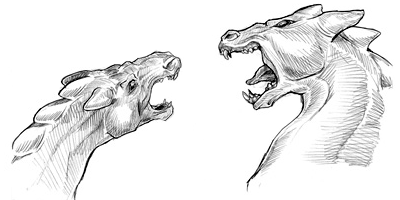Kitti Ping’s vision
“‘Kitti Ping kept as much natural instinct as possible'” (Dragonsdawn, p 353)
Fire-lizards display few scruples when it comes to bonding with humans. If food is offered and compassion demonstrated, virtually anyone may Impress a fire-lizard of any colour.
From the outset, it was required that the Impression bond between dragons and humans be many levels deeper than the often superficial attachment of fire-lizards. In order to be a useful, trainable force in the fight against Thread, dragons’ intelligence had to be enhanced beyond that of the flighty, elemental and child-like natives. And the necessary longevity of the bond meant that rider and dragon would benefit from compatibility of character and purpose.
Kitti Ping – often described as traditional in mindset – envisaged a scenario in which women would Impress only female dragons, and men only the males. She achieved this end only in part. What is certain is that her tinkering was directly responsible for the like to like gender pairings that the first dragons made with their riders, and this change from the fire-lizard template is largely, though not entirely, in evidence through canon.
But to what extent can we attribute the other criteria used by a hatchling dragon in choosing his rider to the foresight of one elderly woman? Kitti certainly made dragons more discerning than fire-lizards, but it is much less likely that she purposely or farsightedly programmed in every quirk and factor affecting a dragon’s choice of rider. It should be remembered that Kitti Ping was neither a philosopher nor a sociologist. Her understanding of biology and genetics was outstanding, but working in haste and under enormous pressure to produce an answer to the threat of Thread, she could not possibly have had the time or expertise to consider every social and cultural possibility that might result from the creation of her dragons.
Indeed, Bay remarks, “‘Kitti Ping kept as much natural instinct as possible,'” (Dragonsdawn, p 353), and nowhere is this more evident than in the choices of green dragonets. Kitti’s tampering could have resulted in the deaths of dozens of green hatchlings when female candidates became scarce. But the same powerful will to live that can drive fire-lizards to cannibalism overrode the greens’ artificial need for female riders: if girls were not available, green hatchlings chose boys rather than die unImpressed. This inherited pragmatism trumps Kitti’s traditionalist programming, and yet serves her ultimate purpose: the creation of an effective and viable fighting force against Thread.
So a dragonet’s pursuit of Impression is not easily thwarted, but dragons certainly don’t choose as arbitrarily as fire-lizards. What, then, makes a hatchling choose one candidate over another? Canon frequently tells us one thing and shows another. Anne’s science is often shaky at best, and the superstition and reverence surrounding dragons makes for unreliable narration. But conclusions can be drawn from the text, in what is said, what is implied, and what is left unsaid. A dragonet’s particular needs may not be precisely quantifiable, but neither is the matter of dragon choice a completely impenetrable mystery.
Continue to The bottom line
If you enjoyed this...
...why not try reading the Dragonchoice trilogy - epic, novel-length Dragonriders of Pern fan fiction?

